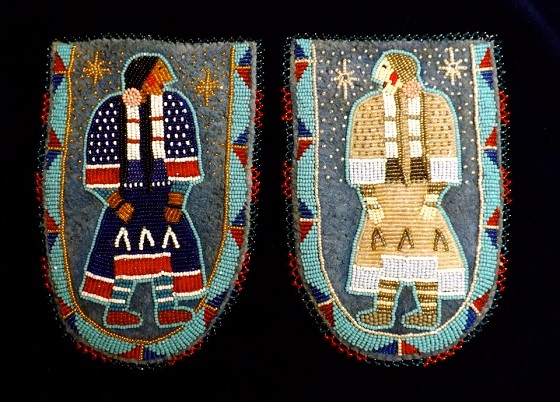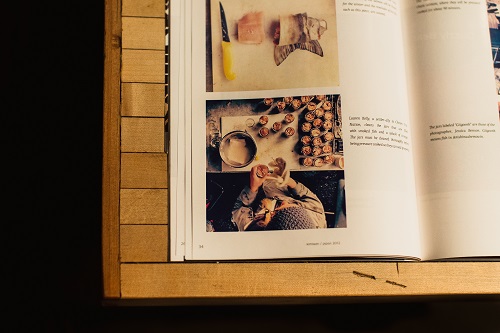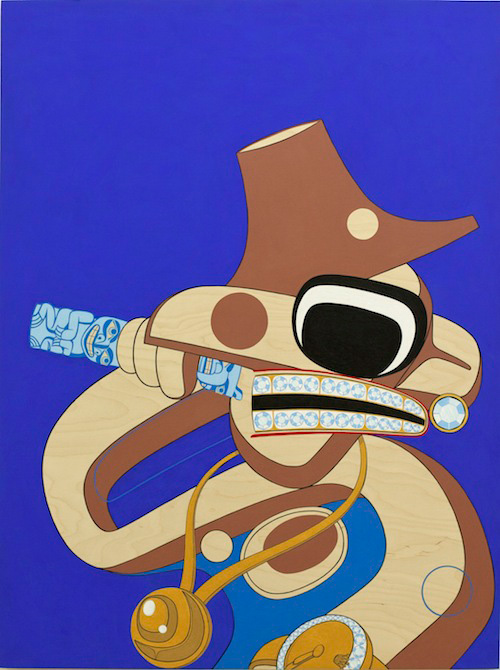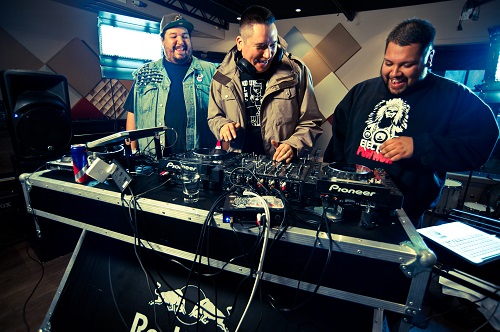moccasins by Angela Swedberg, photo by Christi Belcourt
INSPIRED BY IDLE NO MORE, FIRST NATIONS, METIS AND INUIT INDIE ARTISTS ARE ON THE RISE, BRINGING CONTEMPORARY PERSPECTIVES TO AGELESS TRADITIONS.
by Kelly Boutsalis
For most, the Northwest Coast style of Aboriginal art — with its myth driven, animal based paintings combining thick, dramatic strokes of red and black and expert use of white space — forms the dominant image of Native art. And if it’s not the Northwest Coast style, then it’s the work of iconic artist Norval Morrisseau, who launched the Woodland school of art, practiced by First Nations artists in northern Ontario and southwestern Manitoba. Think brightly coloured paintings of people, animals and plant life inspired by visions and dreams.
In the years leading up to and following Morrisseau’s death, First Nations, Métis and Inuit artists have sought to find that edge between recognizing the work of their ancestors while incorporating a more boundary-pushing contemporary approach; keeping the traditional colours, techniques and themes, but adding modern influences like hip hop and house music, as well as a healthy dose of political and social commentary. The mythology is still there, but today’s Native artists are more willing than ever to let the news of the day dictate their work.
KIMIWAN ZINE
photo courtesy of sweetmoon photography
Cousins Joi Arcand and Mika Lafond, both Cree, wanted to capture new developments in the Aboriginal arts, so they launched a quarterly zine to showcase new and established artists and writers.
Based in Saskatoon, the first issue of Kimiwan (which means “rain” in Nēhiyawēwin Plains Cree) started receiving submissions almost immediately after the open call was published on Tumblr and Twitter. Submissions of art and writing came in from across Canada and the US, plus diverse regions ranging from New Zealand to South America.
Arcand, a graphic designer by day, became intrigued with zines when she lived in Vancouver where she got involved with the Radical Art in Nature collective and its zine, Rain’zine. After helping with the zine’s design and layout, and teaching workshops on zine making, Arcand moved back to Saskatchewan this past summer and wanted to revive the DIY spirit in her new home. She teamed up with her cousin, who was working on her MA in creative writing. Arcand focuses on layout and design while Lafond handles the writing and editing.
“I can feel a bit of a resurgence going on,” said Arcand, of the art she encounters while putting together the zine.
Issue one was distributed in December and was made up of illustrations, poetry, photography and creative non-fiction from artists such as Erin Marie Konsmo, whose spray paint and Sharpie-based work addresses environmental and sexual health issues. It also includes work from Jeneen Frei Njootli, a member of the Vuntut Gwich’in First Nations and multimedia artist who focuses on cultural commodification. Kimiwan is printed in glossy full colour to best represent the works of all its contributors.
There was no specific theme to Arcand’s call, but she wound up receiving many submissions that addressed identity in some way. The bulk of issue two, which launched on March 21, focuses on Idle No More, which began dominating Twitter just days before the first issue went to print.
SHAWN HUNT
Shawn Hunt, Master of Ceremony (shawnhunt.net)
Kimiwan contributor Frei Njootli co-created a sculpture with Métis artist Dylan Minor that debuted in the Vancouver Art Gallery last year as part of the special exhibit Beat Nation: Art, Hip Hop and Aboriginal Culture. Their lowrider bike, decorated with caribou ribs, moccasin patterns and more traditional elements, is called Anishnaabensag Biimskowebshkigewag (Native Kids Ride Bikes). The show also featured videos and a turntable and mixing board carved out of walnut and spruce. But perhaps the most jarring images came from paintings like artist Shawn Hunt’s “Master of Ceremony,” a bright blue Northwest Coast style painting with a twist.
The snake/bird like figure at the center of the painting sports a hat typical of the Haida people, and the traditional shapes of a Northwest Coast painting are at the core, but Hunt gives his Master of Ceremony a grill on his teeth and a totem pole microphone stand in his hand.
Hunt, who is of Heiltsuk, French and Scottish descent, started out doing photo-based work then transitioned to jewelry. His most notable work is a large-scale architectural piece — a carved entranceway to a private residence — which he made with his dad and brother. While carving every day, he decided to start painting. His work is currently being shown at Macaulay & Co. in Vancouver and was even featured in an episode of Real Housewives of Vancouver. (He doesn’t own a TV, and hasn’t seen it.)
Based out of East Vancouver, Hunt, who comes from an artist family, says, “I grew up surrounded by Heiltsuk art, so for me that’s just how I see the world. As for the contemporary…I’m alive right now, I’m looking around and painting and carving what I see.” So what does Hunt see? “I’m inspired,” he says. “I’m seeing more and more diversity, and a real sense of freedom in the work. Especially in the younger people.”
A TRIBE CALLED RED
A Tribe Called Red photo by Athena Anasthasiou
While Hunt is visually remixing with paint, Ottawa-based A Tribe Called Red is literally remixing centuries-old music with genres found in the clubs. The group’s music has rocketed onto playlists with its unique blend of “pow wow step,” a mix of electronic dance music and traditional pow wow music.
The collective — Ian “DJ NDN” Campeau of Nipissing First Nation and Dan “DJ Shub” General and Bear Witness, both Cayuga — formed to highlight the fact that they were Aboriginal DJs in Ottawa, and they began hosting Electric Pow Wow club nights. The trio released the album Electric Pow Wow without a record label for free online last year, and has since been long-listed for a Polaris Music Prize and made their way onto a number of critics’ lists, all the while touring with their blend of pow wow music, dancehall, moombahton, electronic, dubstep and reggae.
A Tribe Called Red offer more than danceable music at their performances — which are held at art galleries, clubs and SXSW 2013. Bear Witness cues up a video projection of clips of stereotypical “Indians” from old cartoons and western movies, all timed perfectly to the beat.
“It’s not even reinventing, re-doing or updating pow wow music, its just carrying on that same feeling and idea of a pow wow,” says Bear Witness. “The same thing with our parties. These aren’t just club nights, they’re gatherings, more like pow wows are.”
“We make this music for Aboriginal people and we want them to take it and claim it, but it’s not necessarily just for them,” adds DJ NDN.
The trio has been a vocal part of Idle No More, and they’ve released a free track in support of Attawapiskat’s Chief Theresa Spence and the movement, called “The Road.”
CHRISTI BELCOURT
Christi Belcourt has also taken her art and added a socially conscious message, with her upcoming installation, Walking With Our Sisters.
The Métis Espanola-based artist, whose most recent body of work incorporates a technique mimicking beadwork with paint, was recently moved by police reports of missing youth and women posted on her Facebook page. She decided to use her art to honour these missing and murdered Aboriginal women.
“Unfinished moccasins came to mind, so that the tops of the moccasins are the only thing that people are creating for the work, because it represents the unfinished lives of the women,” she says.
Just as the project’s inspiration spawned from Facebook, Belcourt turned to the social media platform to launch a crowd sourced project that called for professional and amateur beaders to create a pair of vamps, also known as uppers, which are the beaded tops of a leather moccasin. Approximately 755 people — women, men, Native and non-Native — have committed to making pairs, and the finished Walking With Our Sisters installation will tour across the country, with stops already booking into 2016.
“There is a lot of art value to the project in that it is using aspects of culture and traditional wear and deconstructing it to produce a contemporary piece/collection. I think it is a way for indigenous artists to represent and stay true to themselves, and at the same time provide the art world with something thought provoking and beautiful,” says contributing artist Adriana Poulette who got involved with the project after hearing about it through social media.
Once the vamps are all collected for the July deadline, Belcourt will cover the entire floor of the gallery with red cloth. Overtop will be a pathway of grey cloth where the moccasin vamps will sit, pair by pair, in a row. Each pair represents one murdered or missing woman, which the Native Women’s Council of Canada estimates totals 582 in the last 20 years. “In order to view the work,” the artist explains, “the audience will have to remove their shoes and walk along the path on that red cloth.”
The names of each moccasin artist will be on a separate list, so as not to take away from the missing women.
Belcourt says her paintings are connected to the installation with the intricate beadwork that each vamp will display, from flowers memorializing deceased sisters to an abstract Idle No More round dance-inspired take. “The beadwork is an appreciation of the artistic legacy that was passed down to us by our ancestors. They created this unique art form and we are the beneficiaries.”








You might be interested in the 1st 3D and monumental portrait of Norval Morrisseau changing into Copper Thunderbird, size 8’x 6′ SEE: YouTube Video/ morrisseau murar- a two year project that encompasses images of the sacred bear, Ojibwa medicine snake and turtle, thunderbird/fish headdress and shaman staff/medicine stick. The portrait was made to honour Morrisseau’s gifts to the world. It has been photographed in the white clay it was sculpted in- and has not yet been cast into bronze. It is looking for a permanent home in Canada.